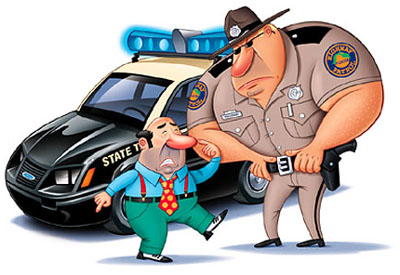
|
CLICK HERE TO START THIS COURSE AND GET THE CERTIFICATE OF COMPLETION |

Chapter
3
Time requirement of chapter: 45 minutes
DRIVER & TRAFFIC KNOWLEDGE
The goal of this Chapter is to assist in your learning and appreciation of the critical driver and traffic knowledge required by all individual's to enable safe, effective operation of a motor vehicle.
To read video transcript CLICK HERE |
|
||||||||||||||||||
The videos you just observed provided you with valuable information on driver
and traffic knowledge. We want to now share some additional information to continue
our efforts to share content relevant to the subject areas covered in the video
segments.
Driving Under the Influence:
Today we hear about “drunk Driving,” and driving while intoxicated.”
Neither of these phrases are correct or accurate terminology.
|
The National Highway Traffic Safety Administration has requested that all traffic safety professionals, trainers, and states stop the common use of drunk or intoxicated driving. The rational for this request is the ambiguity of these terms. Ask ten different individuals for the definition of either being drunk or intoxicated, and you are likely to get ten different definitions. This is why the NHTSA has asked that only the term "impaired" be used. Impairment is a better term to use as it can reflect the results of alcohol, legal and illegal drugs and even fatigue. It really does not matter why a driver is impaired; the fact is that they have chosen to operate a vehicle while their abilities are impaired. |
 |
Driving is demanding and it’s a task that requires both a driver’s mind and body to work effectively. Alcohol interferes with driving because it impairs the driver’s mental and physical abilities. Driving requires a driver’s undivided attention and alcohol interferes with a driver being able to multi-task things such as watching for other vehicles, roadway signs, and controlling the vehicle they are operating.
 |
Judgment is the first important driving ability affected by alcohol. Judgment is what guides a driver’s behavior. Judgment enables a driver to think clearly and make quick, responsible decisions. To drive safely, a driver must be able to judge speed, time and distance accurately. These things are all affected with the very first consumption of alcohol, and become markedly impaired as a person continues to consume alcohol. |
A person whose judgment has been impaired by alcohol may drive too fast or
too slow. They may follow too closely or pass without the proper clearance.
The problem with the consumption of alcohol is the person may not be aware they
are impaired. This is another result of impaired judgment. Some people even
believe the myth that they drive better after consuming alcohol. Nothing could
further from the truth.
Vision is the second factor affected by alcohol.
|
A driver who has consumed alcohol may see the roadway and everything
on it as blurred. They might even be seeing double images of vehicles
and people. About 90% of the information a driver needs to operate a motor
vehicle effectively comes from visual sources. Alcohol will affect a driver’s vision
without the driver even being aware of what’s happening. Alcohol’s
effects on vision begin at low BAC levels. Even one standard drink can
affect a person’s vision. Alcohol has an effect on visual acuity. It causes eye muscles to relax
so light isn’t directed to the eye properly. As a result, objects
become unclear, blurry or fuzzy. Alcohol reduces the ability to see in
low light situations and also affects our ability to recover from glare
situations. Alcohol diminishes a person’s Peripheral Vision which is the ability
to see objects on either side of the head when looking straight ahead.
In fact, at .05 BAC, a driver’s side vision is reduced by as much
as 30%. Depth perception is also affected. Alcohol causes each eye to get a slightly
different picture. This impairs a driver’s ability to gauge distance
and increases the chances of collisions. Alcohol, being a depressant, can also affect emotions leading drivers to act in ways they might nt normally act when sober. |
 |
They may take additional risks, or drive more aggressively. Alcohol has no
positive effects for the operator of any motor vehicle.
Alcohol also affects a driver’s coordination skill. Alcohol slows down
a driver’s reaction time by 15 to 25 percent.
Alcohol consumption will cause a driver to take more time to respond to an immediate hazard.
Resources: http://www.drugsdriving.adf.org.au/browse.asp?ContainerID=drugs_driving_alcohol,http://www.daap.ca/factsondrugsanddriving.html, http://www.nh-dwi.com/caip-218.html.
BLOOD ALCOHOL CONCENTRATION (BAC)
BAC or Blood Alcohol Concentration is a weight of alcohol per volume of blood
or breath.
The American Medical Association has defined the blood alcohol concentration
of impairment for all people to be 0.04 grams/100 liters of blood (equivalent
to .04 grams/210 liters of breath).
Resources: http://padui.org/effect.htm, http://www.nhtsa.gov/people.injury/alcohol/stopimpaired/ABCsBACWeb/page2.htm,
http://websites.afar.org/site/PageServer?pagename=IA_expert_Frederick_Blow.
It is important to understand alcohol impairment begins long before a person reaches the level considered by Florida state statutes to be under the influence to the extent that a person’s normal faculties are impaired.
Some people believe that hard liquor will cause a person to become impaired quicker. In reality (see the graphic below) a 12 ounce can of beer, 5 to 6 ounces of wine and 1.5 ounces of 80 proof alcohol all have relatively the same amount of alcohol per volume.
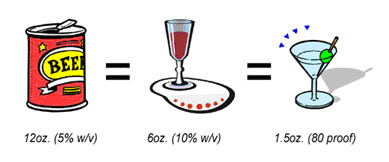
12 ounces of 4% beer 0.48 ounces of absolute alcohol
5 ounces of 10% wine 0.50 ounces of absolute alcohol
1.25 ounces of 40% vodka (80 proof) 0.50 ounces of absolute alcohol
1.25 ounces of 43% whiskey (86 proof) 0.52 ounces of absolute alcohol
All of the above servings have approximately 0.50 ounces of absolute alcohol.
Alcohol is alcohol and no one drink is more potent than another,
unless they are multiple ounce beverages like Long Island Iced Tea which has
between 5 to 7 ounces of alcohol.
How the Body is Affected at Different Levels of BAC:
|
0.02-0.03 BAC: No loss of coordination, slight euphoria and loss of shyness. Depressant effects are not apparent, mildly relaxed and maybe a little lightheaded. 0.04-0.06 BAC: Feeling of well-being, relaxation, lower inhibitions, with a sensation of warmth. There may be euphoria with impairment of reasoning and memory and lowering of caution. A person’s behavior may become exaggerated and emotions intensified with good emotions being better and bad emotions becoming worse. 0.07-0.09 BAC: Impairment of balance, speech, vision, reaction time, and hearing begin. Judgment and self-control are reduced, and caution, reason and memory are impaired, at .08 BAC. In the United States and in the State of Florida, .08 BAC is the presumptive BAC limit at which an individual is presumed to be impaired. You will probably believe that you are functioning better than you really are. 0.10-0.125 BAC: Significant impairment of motor coordination and
loss of reasonable judgment. Speech may be slurred; balance, vision, reaction
time and hearing will be impaired. 0.13-0.15 BAC: Gross motor impairment and lack of physical control.
There will be blurred vision with major loss of balance. Euphoria is reduced
and dysphoria (anxiety, restlessness, depression) begin to appear. Judgment
and perception are severely impaired and the individual will become disoriented. 0.16-0.19 BAC: Dysphoria predominates, nausea may appear. The impaired individual has the appearance of being impaired. Vision, motor skills, & judgment are further impaired. 0.20 BAC: Feeling dazed, confused or otherwise disoriented a person may need help standing or walking. If they are injured they may not feel the pain. Some people experience nausea and vomiting at this level. The gag reflex is impaired and the individual can choke on their own vomit. Blackouts are likely at this level so the person may not remember what has happened. 0.25 BAC: All mental, physical and sensory functions are severely impaired. There is an increased risk of asphyxiation from choking on vomit and of serious injury by falls or other mishaps. A person’s comprehension will be greatly reduced. 0.30 BAC: At this level a person will be in a stupor. They have
little comprehension of where they are. They may pass out suddenly and
be difficult to awaken. 0.35 BAC: This is the level of surgical anesthesia. Coma is possible. 0.40 BAC and up: Onset of coma, and possible death due to respiratory arrest. |
 |
Legal Consequences of Driving Under the Influence:
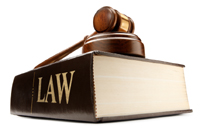 |
Florida State Statute 316.193 defines Driving Under the Influence as
an offense of the law if a person is driving or in actual physical control
of a vehicle within the state and the person is under the influence of
alcoholic beverages or controlled substances. The law applies to
any chemical substances as set forth in the law or any substance controlled
under chapter 893 of the Florida State Statutes when the person is affected
to the extent that their normal faculties are impaired. Florida State Statute 316.193 also sets the presumptive limit in the law. The presumptive limit means an individual has a blood alcohol level of 0.08 or more grams of alcohol per 100 milliliters of blood or the individual has a breath-alcohol level of 0.08 or more grams of alcohol per 210 liters of breath.This limit is so called because a person is presumed to be impaired beyond that level, regardless of the person’s actual ability to function. |
Violations of the Florida State Statute 316.193 are considered to be a serious
crime, and the punishments are stern and the punishments become progressively
more severe with repeated offenses.
Punishment for a First Conviction of DUI:
|
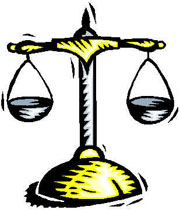 |
For a first conviction, a court may order the installation of an ignition
interlock device.
If the violator had a 0.15 BAC or greater or was operating the vehicle with a minor in the vehicle at the time of the violation, the installation of an ignition interlock device will be required for at least 6 continuous months.
If an ignition interlock device is ordered by the court, then the Department of Highway Safety and Motor Vehicles then requires the ignition interlock device be placed on the violator’s vehicle.
The standard ignition interlock device is an in-vehicle breath screening apparatus
that requires the vehicle operator to pass a breath-alcohol test before their
motor vehicle will start. Typically, the device is located inside the passenger
compartment, near the driver’s seat, and hard wired to the engine’s
ignition system. Once the driver blows into a mouthpiece, the device will determine
if their breath alcohol concentration (BAC) exceeds a pre-set limit. If the
driver’s BAC exceeds the prohibited level, the ignition interlock device
will effectively prevent the vehicle from starting.
Punishment for a Second Conviction of DUI:
 |
|
If a 2nd conviction for DUI is within 5 years of any prior conviction, there
is a mandatory imprisonment of at least 10 days. At least 48 hours of the confinement
must be consecutive.
Punishment for a Third Conviction of DUI:
If a 3rd conviction is within 10 years of any prior DUI conviction, there is
a mandatory imprisonment of 30 days. At least 48 hours of the confinement must
be consecutive.
A 3rd degree felony is punishable by 5 year’s incarceration or a $5,000
fine or both.
|
Punishment for a Fourth or Subsequent Conviction of DUI:
|
 |
A person whose driving privilege has been permanently revoked because he or she has been convicted four or more times of violating FSS 316.193, Driving Under the Influence, may upon the expiration of 5 years after the date of the last conviction or the expiration of 5 years after the termination of any incarceration for a conviction of DUI (whichever is later) may petition the department for reinstatement of his or her driving privilege.
Within 30 days after receipt of a petition, the department shall provide for a hearing, at which the petitioner must demonstrate that he or she:
At the hearing, the department shall determine the petitioner's qualification, fitness, and need to drive. After such determination, they may reinstate the petitioner's driver's license. The reinstatement shall be subject to the following qualifications:
If, after reinstatement, the petitioner is convicted of an offense for which mandatory license revocation is required, the department shall revoke his or her driving privilege.
A person may not be issued a commercial driver's license during a period in which such person is disqualified from operating commercial motor vehicles or in which the driving privilege of said person is suspended, revoked, or cancelled.
Resources: Florida State Statutes: 322.271 (5)
Conditions for release from incarceration after a DUI arrest:
Misdemeanor DUI Conviction:
A violator who is found guilty of driving while under the influence and has been involved in a collision causing property damage or personal injury is guilty of a first-degree misdemeanor. A first-degree misdemeanor is punishable by a fine of $1,000 or imprisonment of up to 1 year (potentially both).
Felony DUI Conviction:
An individual is guilty of a third-degree felony, punishable by fines of up
to $5,000 and/or 5 year’s incarceration, if they: are found guilty of a
fourth or subsequent DUI, have caused any serious bodily injury while driving under
the influence, or have been classified by the court as a habitual/violent offender
at the time of their conviction for DUI.
|
Manslaughter: An individual involved in a collision while under the influence and who causes the death of another may be charged with manslaughter. Manslaughter is a second-degree felony punishable by a fine of up to $10,000 or 15 years in jail (potentially both). An individual who is under the influence and is involved in a collision and then leaves the scene is guilty of a first-degree felony, punishable by a fine of up to $10,000 or 30 year’s incarceration (potentially both). Vehicular Homicide: An individual involved in a collision which results in death to another
as a result of the operation of a motor vehicle in a reckless manner which
is likely to cause death or great bodily harm may be charged and convicted
of vehicular homicide. Vehicular homicide is a second-degree felony punishable
by a fine of up to $10,000 or imprisonment for up to 15 years (potentially both).
An individual convicted of vehicular homicide who also left the scene
of a collision is guilty of a first-degree felony punishable by a fine
of not more than $10,000 or 30 year’s incarceration (potentially both). |
 |
Resources: Florida State Statutes: 316.193, 316.1937, 316.1938
Synergism:
Synergism comes from the Greek word “synergos” meaning working together. It refers to the interaction between two or more “things” when the combined effect is greater than if you added the “things” on their own. It provides a one plus one is greater than two effects.
|
In toxicology, synergism refers to the effect caused when exposure to
two or more chemicals at the same time results in health effects that are greater
than the sum of the effects of the individual chemicals. When chemicals are synergistic, the potential hazards of the chemicals should be re-evaluated, taking their synergistic properties into consideration. Synergism occurs when drugs interact in ways that enhance or magnify one or more effects, or side effects, of those drugs. The combination can cause a greater reaction than simply the sum of the individual effects of each drug if they were used separately. (1 + 1 does not always = 2). The most serious consequence of drug synergy is overdose, which can be fatal if left untreated. |
 |
Due to the fact that there is no quality control with illicit (illegal) drugs, there is no set formula for determining the combined effect of alcohol and a specific drug like marijuana or cocaine from episode to episode of use. This makes it much more dangerous, as you never know what you will be getting each time you use. Alcohol can magnify the effects of any drug.
Resources: Florida State Statutes: http://answers.com/topics/synergy?cat=health,
http://www.doitnow.org/pages/121.html.
Alternatives to Driving Impaired:
The best alternative is to never consume alcohol and/or other drugs and then
drive. The second best alternative is to never get into a vehicle with a driver
who has consumed any amount of alcohol. Even one standard drink can impair a
person’s ability to drive.
Resources: Florida State Statutes: http://nhtsa.dot.gov/people/injury/alcohol/innocent/index.html,
http://www.old-colony.com/howto.htm, http://www2.potsdam.edu/hansondj/DrivingIssues/1074792978.html.
Safety Restraint Systems:
Seat Belts:
|
Research has shown that lap/shoulder belts, when used properly; reduce the risk of fatal injury to front-seat passenger vehicle occupants by 45% and the risk of moderate to critical injury by 50%. Safety belts should always be worn, even when riding in vehicles equipped with air bags. The needless deaths and injuries from safety belt non-use result in an estimated $26 billion in economic costs to society annually. The cost of unbuckled drivers and passengers goes far beyond those killed and the loss to their families. We all pay in higher taxes and higher health care and insurance costs. Florida State Statute 316.614 requires all individuals while operating a motor vehicle to be properly restrained in the vehicles safety restraint system. The law also requires all front seat passengers to wear safety belts. Violation of the seat belt law is a Primary Offense, meaning a law enforcement officer has the legal right to stop a vehicle if any driver or front seat passenger is not properly wearing a seat belt. Any passenger under the age of 18 must be properly restrained regardless of where they are seated in a vehicle. Violation of a passenger under 18 not being properly restrained is a Primary Offense, meaning an officer does not have to have another reason to stop the vehicle. |
 |
The definition of a motor vehicle under the law does not include school buses, a bus used for transportation of persons for compensation, a farm tractor or implement of husbandry, a truck with a net weight of more than 5,000 pounds or a motorcycle, moped, or bicycle.
Any individual who violates the, “Florida Safety Belt Law,” commits a non-moving violation which has a violation fine of $30.00 plus a court cost fee. It is a driver’s responsibility to ensure that all front seat passengers and all passengers under the age of 18 regardless of where they are seated in the vehicle, are properly secured in the vehicle’s safety restraint system.
Lap belts should be worn when sitting well back and erect in the seat. The belt portion should fit snugly and as low on the hips as possible. Shoulder belts should be positioned to provide comfort, fit snugly and allow some movement. An occupant should never place a shoulder belt under their arm or behind their back as this may cause serious injury or death if the vehicle is involved in a collision. If the vehicle has an automatic shoulder belt, it is extremely important that the lap belt be properly secured. Leaving the lap belt off can result in serious injury.
Resources: Florida State Statutes: 316.61, 318.18, http://www.michigan.gov.msp/0,1607,7-123-1593_3504_22774-43545--,00.html,
http://www.bouldercounty.org/transportation/traffic_safety/seatbelt.htm.
Child Restraints:
Motor Vehicle Traffic Collisions are the leading cause of death of children in the United States. The proper use of child restraint devices could greatly lower this terrible statistic.
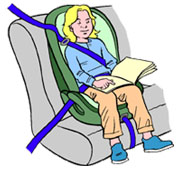 |
Florida law states that every driver while transporting a child in a motor vehicle operated on the roadways, streets, or highways of the State of Florida, shall, if the child is 5 years of age or younger, provide for protection of the child by properly using a federally approved, crash-tested, child restraint device. Children aged through 3 years shall be secured in a restraint device
that is a separate carrier or a vehicle manufacturer’s integrated
child seat. Children aged 4 through 5 years may be secured in a separate
carrier, an integrated child seat, or the vehicle seat belt system. |
It is important to remember that drivers are responsible and subject to receiving citations if they fail to ensure that all individuals under the age of 18 are properly secured in the vehicle’s safety restraint system or, if they are five years of age or younger, provide for protection of the child by properly using a crash-tested, federally approved child restraint device.
Remember, it is important that child restraint devices be properly installed.
It is illegal for any parent, legal guardian, or other person responsible for any child younger than 6 years of age to leave a child unattended or unsupervised in a motor vehicle for a period in excess of 15 minutes. However, it is illegal under this law to leave a child unattended for any period of time if the motor of the vehicle is running or the health of the child is in danger.
Even though the law allows a child less than six years of age to be left unattended,
that because of the Florida heat this can be a very dangerous decision and may
put the child’s health in danger. It may even violate the Florida child
abuse laws.
Resource: http://www.nhtsa.dot.gov/people/injury/childps/newtips/pages/Tip1.htm,
http://www.ysa.safekids.org/skbu/cps/index.html, Florida State Statutes: 316.613,
316.6135, and 318.18.
Headrests:
|
The proper positioning of a vehicles headrest is important to prevent
whiplash. Whiplash is a term used to explain how the heads of vehicle
occupants accelerate faster and harder than the torso when the vehicle
is involved in a collision. The term comes from the sound when someone
cracks a whip. Headrests should be designed so they are directly behind
the occupants head and even with the center of the individual’s ears.
Headrests prevent whiplash, which occurs when the head is forced backwards
as a result of a collision. The National Highway Safety Administration has issued a new head-restraint
standard in order to reduce whiplash injuries. For front seats, the rule
establishes a higher minimum height requirement, a requirement limiting
the distance between the back of an occupant’s head and the occupant’s
head restraint, as well as a limit on the size of gaps and openings within
head restraints. The rule also establishes new strength and dynamic compliance
requirements, and amends most existing test procedures. In addition, the
rule establishes requirements for head restraints voluntarily installed
in rear outboard designated seating positions. The upgraded standard became
mandatory for all vehicles manufactured on or after September 1, 2008.
Until that time, the manufacturers may comply with the existing NHTSA
standard, the upgraded NHTSA standard or the current European regulations.
|
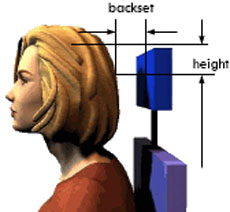 |
Resources: http://www.nhtsa.dot.gov/cars/rules/rulings/HeadRest/Index/html,
http://www.garageboy.com/fahrt/headrest.html, http://www.ibc.ca/en/Car_Insurance/Road_Safety/Rest_Up_Save_Your_Neck.asp.
Driving in Cities, Rural Areas and Expressways:
While driving in a metropolitan area a driver will encounter numerous intersections and crossing traffic. The may be detours, irregular traffic lanes and possible road defects. There will be other roadway users such as pedestrians, bicyclists and emergency vehicles. There are also more sight obstructions and typically heavier traffic.
With these thoughts in mind, here are some important ways to scan the roadways
when driving in a city.
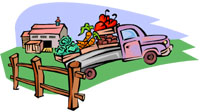 |
Driving in rural areas has its own special hazards. Rural roads may have
hills, curves, and there may be different types of road surfaces. Poor
shoulders are a possibility and there may be ditches on the sides of the
roads. Open country roads many times have higher speed limits and fewer
controls. A driver may encounter slow moving vehicles. Trees, bushes,
weeds, and tall crops can all obstruct a driver’s view. A driver
may also encounter animals on the roadway. Utilize these tips for scanning when driving in the country. |
There are some drivers that believe travelling on the interstates is much easier than driving in the country or cites and therefore let their guard down and do not pay as much attention to the task of driving. This can be a very dangerous decision.
Here are some tips for driving on interstates:
Resource: http://www.dmv.ca.gov/pubs/hdbk/pgs33thru41.thm,scanning
Signs, Signals and Roadway Markings:
As drivers we are subjected to a lot of information as we travel on the roadways.
We must therefore be aware of all other traffic including individuals riding bicycles,
pedestrians, traffic signs, signals, roadway markings and business
advertisements. Traffic signs and signals not only provide valuable information
through written information, but they are also color coded to assist drivers
in recognizing the type of information the sign is providing.
There are eight different color schemes to assist drivers in recognizing the
different type of signs. The following is a description of each of the eight
signs and colors.
| Yellow | General Warning |
| Brown | Recreation areas and scenic guidance |
| Red | Do Not Enter or Wrong Way |
| Green | Guide, directional information |
| Orange | Construction, maintenance warning |
| White/Black | Regulatory |
| Blue | Motor Service Guidance Also used to identify parking spaces for disabled drivers |
Resource: http://www.icbc.com/licensing/RoadSense%20for%20Drivers%20PDFs/RoadSense_for_Drivers_Signs_Signals_and_Road_Markings_MV2075.pdf
GREEN LIGHTS
Florida State Statute 316.075 requires vehicular traffic facing a circular green signal to proceed cautiously straight through or turn right or left unless a sign at such place prohibits either such turn. Vehicular traffic, including vehicles turning right or left, shall yield the right-of-way to other vehicles and to pedestrians lawfully within the intersection or an adjacent crosswalk at the time such signal is exhibited.
YELLOW LIGHTS
A driver facing a steady yellow signal is warned that the related green movement is being terminated or that a red indication will be exhibited immediately and should stop before the white lateral line of the roadway unless such stop would be a danger to themselves or other vehicles.
RED LIGHTS
A driver facing a steady red signal shall stop before entering the crosswalk on the near side of the intersection or, if none, then before entering the intersection and shall remain stationary until a green indication is shown. The stop shall be made before the white lateral stop line or if there is no line the stop is to be made before the nearest intersecting roadway where the driver has a view of approaching traffic.
A right turn on red is permissible if there is no posted sign prohibiting such turn. When any right turn on red is made a driver must yield to any pedestrian or cyclist in the intersection. A two-way signal is to direct traffic flowing from two different directions with the exception of signals with turning arrows that should be in accordance with one another.
When a traffic light malfunctions the intersection automatically become a stop intersection requiring a vehicle to stop before proceeding.
Resource: Florida State Statute: 316.075
Flashing Yellow Arrow
A flashing yellow arrow means left turns are allowed. Yield to oncoming traffic and pedestrians. The oncoming traffic has a green light.
Green Arrow
A green arrow, pointing right or left, means you may make a turn in the direction of the arrow. If the red light is illuminated at the same time, you must be in the proper lane for such a turn and you must yield the right-of-way to vehicles and pedestrians clearing the intersection.
Flashing Signals
A flashing red light means the same thing as a stop sign. It is used at dangerous intersections. A flashing yellow light means you may move forward with caution. It is used at, or just before, dangerous intersections, or to alert you to a warning sign such as a school crossing or sharp curve.
Yield signs are red and white with red letters. The yield sign informs a driver to an upcoming hazard or road condition that does not reflect an immediate condition. A yield sign requires a driver to slow down and stop when necessary and may proceed when safe to do so. A flashing yellow light has the same meaning as a yield sign.
Stop signs are red with white letters. Stop signs require a driver to make a mandatory stop and proceed only when it is safe to do so. At a stop sign, the purpose of the white painted limit line is to prevent the driver from entering the crosswalk or intersection inadvertently or at an excessive speed and shows the driver where to make the stop before proceeding through. Rolling stops are not acceptable. A driver must come to a complete stop before proceeding through the intersection. A flashing red light has the same meaning as a stop sign.
Drivers are required to stop prior to any marked crosswalk and at the white lateral stop line. If there is no marked crosswalk, a driver is required to stop prior to an intersection sidewalk and if none then prior to the intersecting intersection.
Double yellow lines mean no passing. However, a driver may by law make turns over and left turns out of a driveway and crossovers from driveway to driveway as long as the flow of traffic is not impeded and no excessive speed is used. If oncoming vehicles must slow or make drastic maneuvers, these are not safe actions.
Resource: Florida State Statute: 316.076, 316.123Florida State Statute: 316.089.
Single broken yellow lines indicate traffic flowing in two (opposite) directions, while a single broken white line signals traffic flowing in two lanes in the same direction. Most single broken yellow lines are seen on two lane rural roadways. A single broken white line indicates to drivers that traffic is flowing in two lanes in the same direction. A driver should only cross broken lines with caution, when it is legal, safe, and necessary to do so.
A road limit line is the white lateral painted line on a roadway. It normally marks the confines of an intersection or the place where a driver is required to stop. A driver must stop behind the limit line at an intersection or street controlled by a traffic light and proceed when the signal changes. If a driver cannot see traffic clearly they are required to stop at the limit line and then move forward and stop again before crossing a roadway or entering an intersection.
At a street or intersection with a stop sign, the driver shall stop behind the limit line and then proceed out into the intersection at a cautious speed to start a turn or other maneuver. On roads or intersections without limit or crosswalk lines, the driver should use the end of the curb as a determination of where the intersection starts and where the vehicle should stop. At a blind intersection, the driver should go no more than 15 mph and exercise extreme caution.
Resource: Florida State Statute: 316.089.
Bicycle lanes were designed for the use of cyclists. Drivers may not drive in a bicycle lane unless they are entering or leaving the highway, making a turn or parking where parking is permitted, but not in the bicycle lane. Bicycle riders must ride in the bicycle lane if they are available. Bicycle lanes should be entered and driven through with extreme caution.
Crosswalks are designed for pedestrians to cross the road safely. Crosswalks may be painted on the roadway and may be controlled by Walk and Don’t Walk Signs or a Crosswalk may be unmarked. If the crosswalks are marked, a driver must stop at the marked limit line or if unmarked, a driver must stop before entering the intersection.
A driver approaching an intersection shall yield the right-of-way to any vehicle which has entered the intersection from a different highway. When two vehicles enter an intersection from different highways at the same time the driver of the vehicle on the left shall yield the right-of-way to the vehicle on the right. A driver of a vehicle about to enter or cross a state-maintained road or highway from a paved or unpaved road and not subject to control by an official traffic control device shall yield the right-of-way to all vehicles approaching on the state-maintained road or highway.
Resource: Florida State Statute: 316.1995, Florida State Statute: 316.130, Florida State Statute: 316.121
At selected intersections a driver may encounter turn lanes. These lanes are designed for completing either left or right turns. The lanes may be controlled by turn arrow signals which provide an indication to a driver when a turn may be legally made. Drivers need to keep in mind if there is a red turn signal arrow, a driver may not proceed until there is a green arrow signal. The arrow signal will direct the driver in the direction they are to travel. Green, yellow and red turn arrow signals have the same meaning as green, yellow and red traffic signals.
A driver of a vehicle overtaking another vehicle proceeding in the same direction shall signal using either hand signals or the vehicles turn signals and shall pass to the left of the vehicle ahead at a safe distance, and shall not again drive to the right side of the roadway until safely clear of the overtaken vehicle.
Except when overtaking and passing on the right is permitted, a driver of an overtaken vehicle shall give way to the right in favor of the overtaking vehicle, on audible signal or upon the visible blinking of the vehicles headlamps of the overtaking vehicle if such overtaking is being attempted at nighttime, and shall not increase the speed of their vehicle until completely passed by the overtaking vehicle.
No vehicle shall be driven to the left side of the center of the roadway in overtaking and passing another vehicle proceeding in the same direction unless such left side is clearly visible and is free of oncoming traffic for a sufficient distance ahead to permit such overtaking and passing to be completely made without interfering with the operation of any vehicle approaching from the opposite direction. In every event the overtaking vehicle must return to an authorized lane of travel as soon as it is feasible to do so and, in the event the passing movement involves the use of a lane authorized for vehicles approaching from the opposite direction, before coming within 200 feet of any approaching vehicle.
No vehicle shall be driven from a direct course in any lane on any highway until the driver has determined that the vehicle is not being approached or passed by any other vehicle in the lane or on the side to which the driver desires to move and that the move can be completely made with safety and without interfering with the safe operation of any vehicle approaching from the same direction.
No vehicle shall at any time be driven to the left side of the roadway under the following conditions:
| (a) | When approaching or upon the crest of a grade where the driver’s view is obstructed within such distance as to create a hazard in the event another vehicle might approach from the opposite direction; |
| (b) | Upon a curve in the highway where the driver’s view is obstructed within such distance as to create a hazard in the event another vehicle might approach from the opposite direction; |
| (c) | When approaching within 100 feet of or traversing any intersection, except that this section shall not apply to any intersection on a state-maintained or county-maintained highway located outside city limits unless such intersection is marked by an official Department of Transportation or county road department traffic control device indicating an intersection either by symbol or by words and such marking is placed at least 100 feet before the intersection; |
| (d) | When approaching within 100 feet of or traversing any railroad grade crossing; |
| (e) | When the view is obstructed upon approaching within 100 feet of any bridge, viaduct, or tunnel. |
Where signs or markings are in place to define a no-passing zone a driver shall
not at any time drive on the left side of the roadway.
Resource: Florida State Statutes: 316.075, 316.121, Florida
State Statutes: 316.082, 316.083, 316.085, 316.087, 316.0875
CHAPTER 3QUIZ
| Question 1 | Motor Vehicle Traffic Collisions are the leading cause of
death of children in the United States.
|
||||||||
| Question 2 | Alcohol slows down a driver's reaction time by ___ to ___
percent.
|
||||||||
| Question 3 | It is illegal for any parent, legal guardian, or other person
responsible for any child younger than __ years of age to leave a child
unattended or unsupervised in a motor vehicle for a period in excess of
15 minutes.
|
|
CLICK HERE TO START THIS COURSE AND GET THE CERTIFICATE OF COMPLETION |